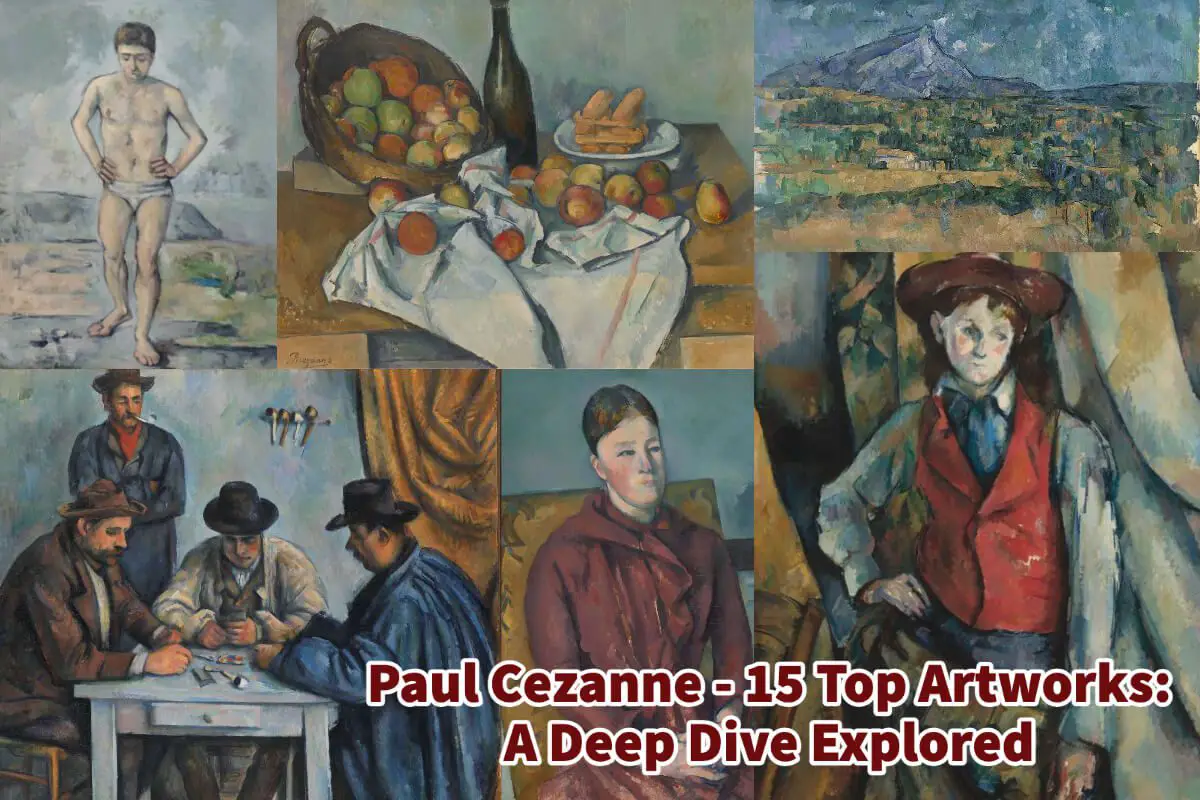Paul Cezanne is one of the top artists that ever lived. He has a legacy and place in history as the father of modern art.
Paul Cezanne, frequently hailed as the “pioneer of contemporary art,” is revered for his innovative style of painting that forms a bridge from 19th-century Impressionism to the dawn of 20th-century Cubism. His signature brushwork, combined with a profound grasp of color and structure, has etched a permanent legacy in the annals of art. Dive into 15 of Cezanne’s most iconic pieces and understand the essence of their lasting impact.
Table of Contents
- Paul Cezanne’s Masterpieces: A Deep Dive Into His Top 15 Artworks
- “The Large Bathers” (1898-1905) By Paul Cezanne
- “Mont Sainte-Victoire” (1904) By Paul Cezanne
- “Still Life with Apples” (1898) By Paul Cezanne
- “Boy in a Red Waistcoat” (1888-1890) By Paul Cezanne
- “The Card Players” (1890-1892) By Paul Cezanne
- “Madame Cezanne in a Yellow Chair” (1888-1890) By Paul Cezanne
- “Jas de Bouffan” (1876) By Paul Cezanne
- “Basket of Apples” (1895) By Paul Cezanne
- “Bather” (1885-1887) By Paul Cezanne
- “Chateau Noir” (1904) By Paul Cezanne
- “The Bay of Marseilles, seen from L’Estaque” (1885) By Paul Cezanne
- “L’Estaque” (1879-1882) By Paul Cezanne
- “Self-portrait with a Beret” (1898-1900) By Paul Cezanne
- “Still Life with Cherub” (1895) By Paul Cezanne
- “Houses in Provence” (1883) By Paul Cezanne
- Frequently Asked Questions
- Related Questions
Paul Cezanne’s Masterpieces: A Deep Dive Into His Top 15 Artworks
Paul Cezanne, often dubbed the “father of modern art,” is celebrated for his unique approach to painting that bridged the gap between 19th-century Impressionism and the burgeoning Cubism of the 20th century.
Paul Cezanne (1839-1906) was a pioneering French Post-Impressionist painter whose innovative techniques and style bridged 19th-century Impressionism and early 20th-century Cubism. Often referred to as the “father of modern art,”
Cezanne’s unique approach to painting was characterized by his use of repetitive, explorative brushstrokes, planes of color, and a deep understanding of structure and form. While initially met with criticism and skepticism, his later works achieved acclaim for their forward-thinking style, laying the groundwork for many art movements of the 20th century.
Cezanne’s relentless pursuit of capturing the essence of nature and his profound study of visual perception has cemented his legacy as one of art history’s most influential figures.
His distinctive brushstrokes and an unparalleled mastery of color and composition have left an indelible mark on the art world. Let’s explore 15 of Cezanne’s most defining works and the reasons behind their enduring significance.
“The Large Bathers” (1898-1905) By Paul Cezanne

A monumental work, “The Large Bathers,” is a testament to Cezanne’s persistent fascination with the human figure. The painting showcases nude women set against a lush, idyllic landscape.
The merging of figures with nature and Cezanne’s geometric treatment of the human body set the stage for subsequent avant-garde movements.
“Mont Sainte-Victoire” (1904) By Paul Cezanne
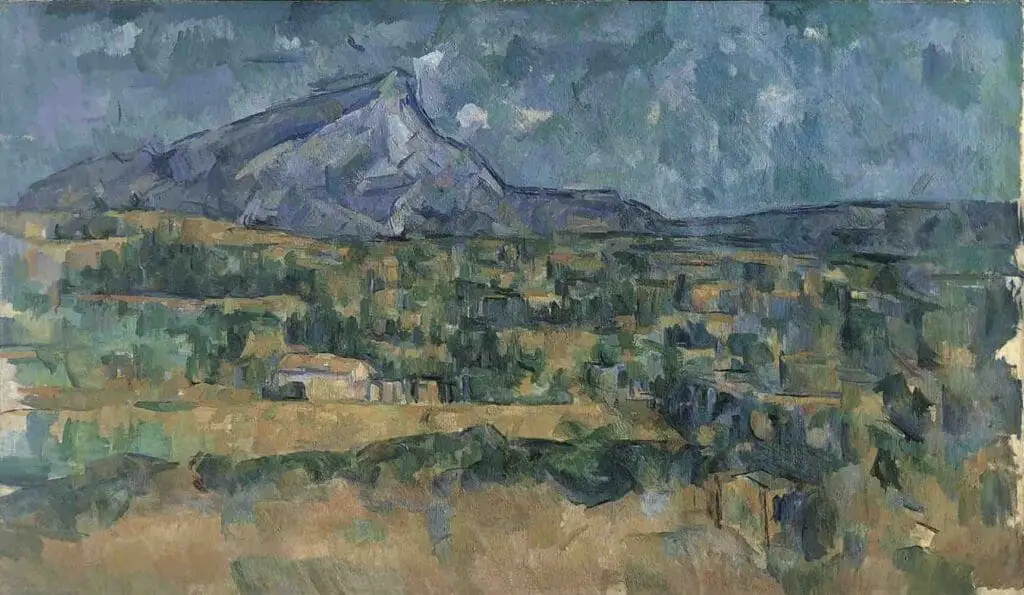
Cezanne’s series of the Mont Sainte-Victoire is a homage to the Provençal landscape. The 1904 rendition stands out for its crystalline precision and exquisite color palette.
It exemplifies Cezanne’s unique method of capturing nature by using small, repetitive brushstrokes to build up form.
“Still Life with Apples” (1898) By Paul Cezanne

Cezanne’s still lives are no mere depictions of inanimate objects. “Still Life with Apples” is a masterclass portraying depth and form using color. The meticulous arrangement and the contrasting colors underscore Cezanne’s ability to bring vibrancy and depth to everyday scenes.
“Boy in a Red Waistcoat” (1888-1890) By Paul Cezanne
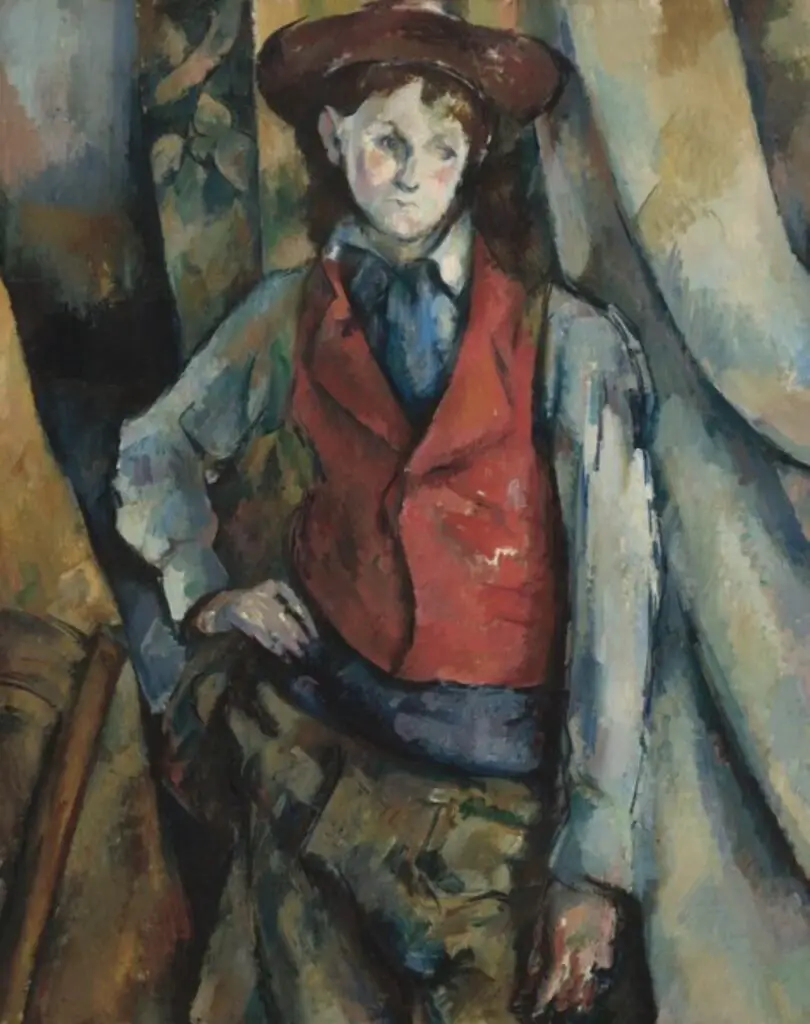
With its mesmerizing textures and tones, this painting captures a boy in a contemplative pose. Cezanne’s talent for combining rich color with intricate detail showcases his departure from impressionistic softness, moving towards a more structural form.
“The Card Players” (1890-1892) By Paul Cezanne
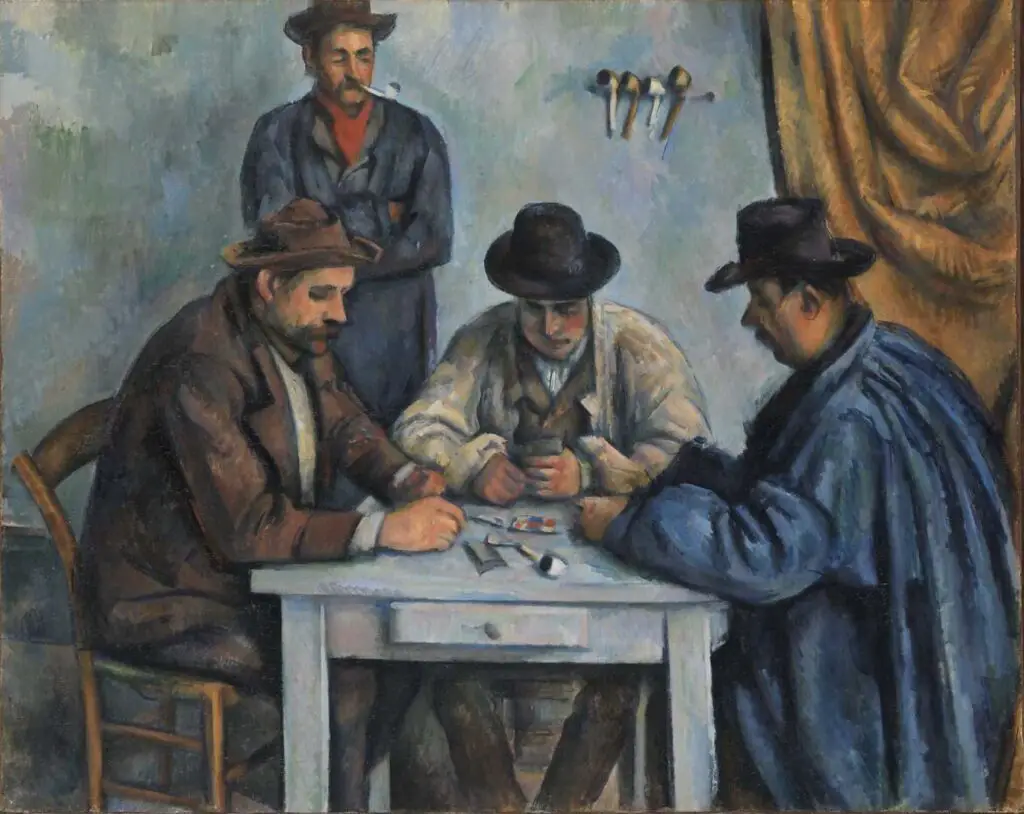
This series of paintings captures peasants engrossed in a game of cards. The solemnity and concentration of the players are palpable. Cezanne’s focus on geometric shapes and structure within the human figure was groundbreaking and influential.
“Madame Cezanne in a Yellow Chair” (1888-1890) By Paul Cezanne
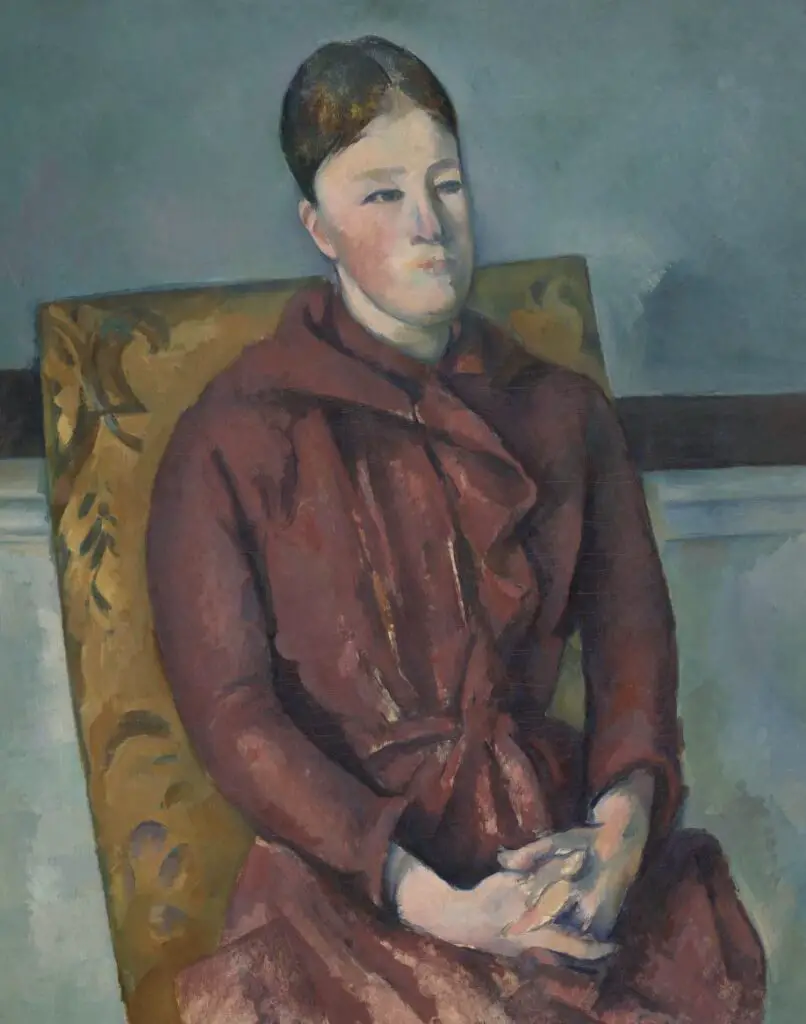
A profound portrait of his wife, this artwork is a brilliant amalgamation of color and emotion. The juxtaposition of Madame Cezanne’s stoic expression against the vivid yellows and blues makes it captivating.
“Jas de Bouffan” (1876) By Paul Cezanne
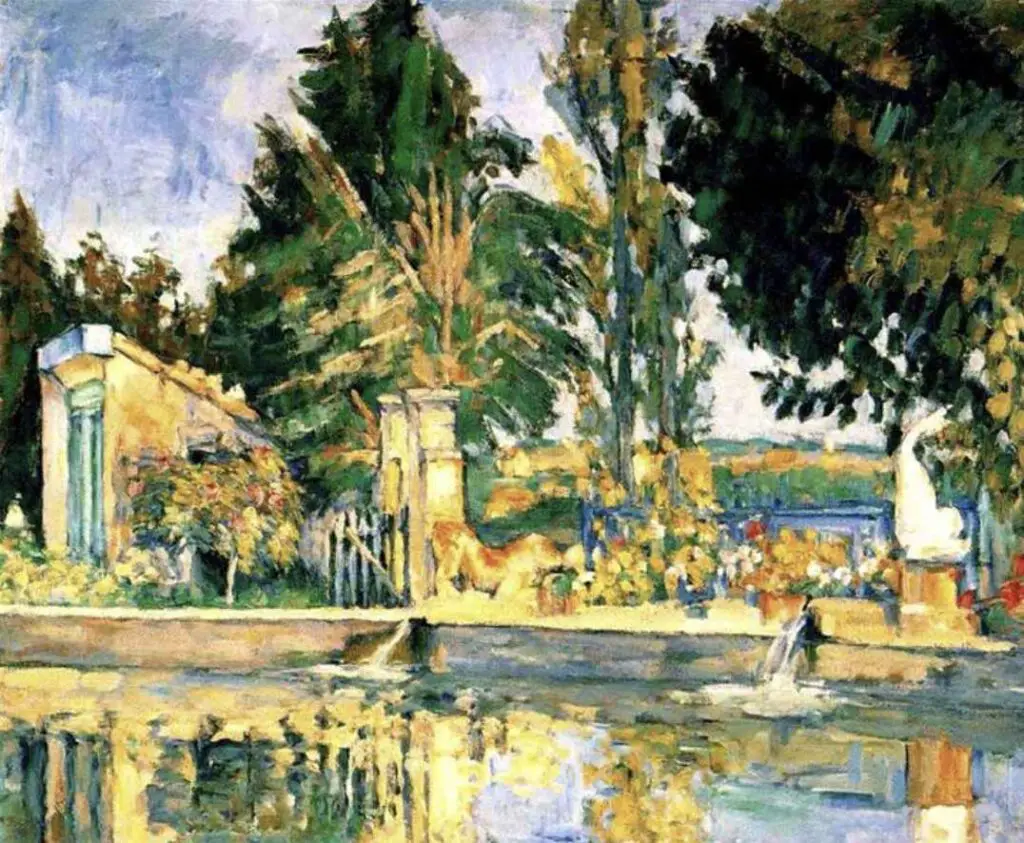
The family estate was one of Cezanne’s favorite subjects. In this artwork, the artist’s fluid brushstrokes and muted tones capture the tranquility and beauty of the Provençal landscape, making it a timeless masterpiece.
“Basket of Apples” (1895) By Paul Cezanne
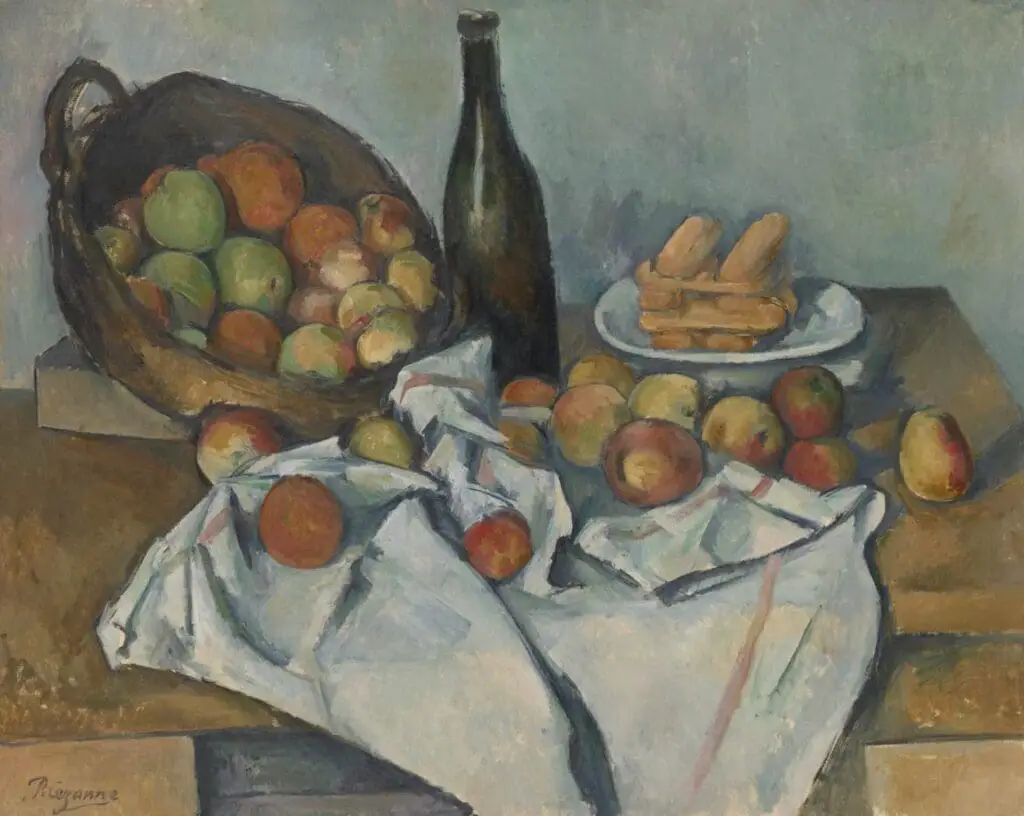
Challenging traditional perspectives, this still life seems to defy gravitational logic. The tilted basket, the scattered fruits, and the uneven tablecloth showcase Cezanne’s ability to break free from conventions and embrace a new artistic narrative.
“Bather” (1885-1887) By Paul Cezanne
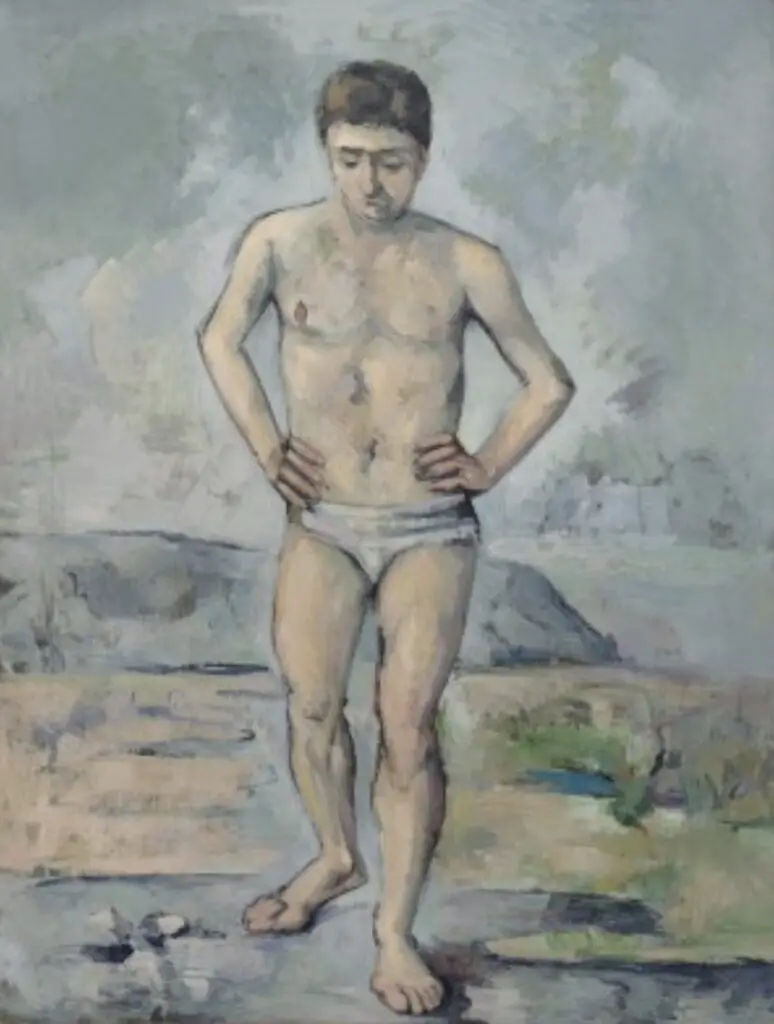
This piece captures the male form with a classical essence. The composition and muted colors evoke a sense of introspection and timelessness, emphasizing Cezanne’s adeptness at blending traditional themes with modern techniques.
“Chateau Noir” (1904) By Paul Cezanne

This artwork stands as a testament to Cezanne’s unparalleled prowess in portraying landscapes. The dark hues, interspersed with vibrant greens, create a mesmerizing contrast, exuding an almost mystical aura.
“The Bay of Marseilles, seen from L’Estaque” (1885) By Paul Cezanne
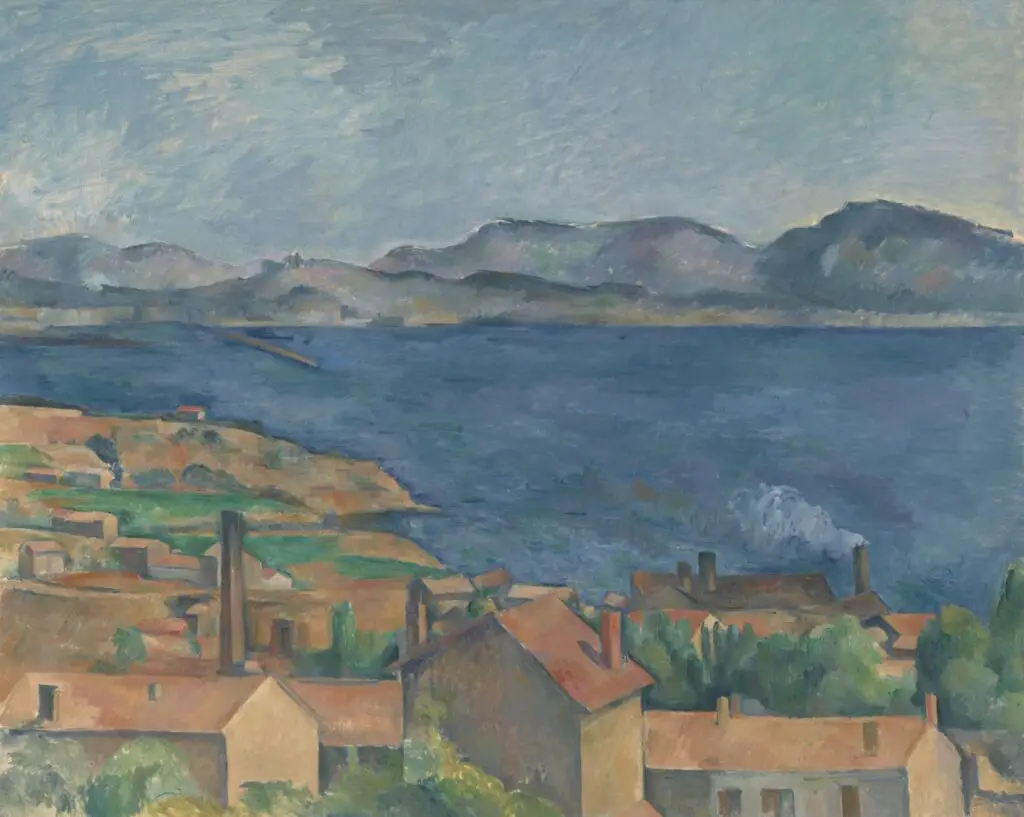
The mesmerizing blues of the sea set against the town’s architecture make this painting an ode to L’Estaque’s beauty. Cezanne’s brushstrokes capture the water’s stillness and the coastal town’s bustling life.
“L’Estaque” (1879-1882) By Paul Cezanne
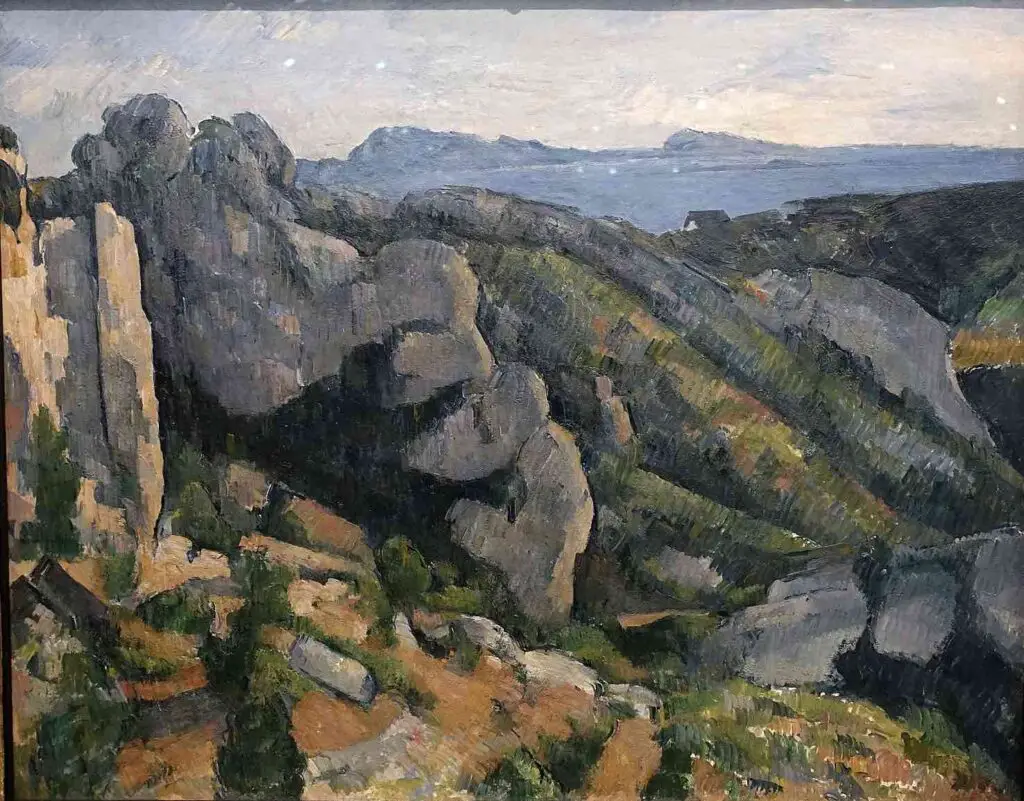
With its radiant blues and greens, this painting exudes the serenity and charm of the Mediterranean landscape. Cezanne’s unique portrayal of light and shadow captures L’Estaque’s essence during different times of the day.
“Self-portrait with a Beret” (1898-1900) By Paul Cezanne

This reflective piece gives us a glimpse into Cezanne’s soul. His penetrating gaze, set against a richly textured background, showcases the artist’s maturity and depth as an artist and an individual.
“Still Life with Cherub” (1895) By Paul Cezanne
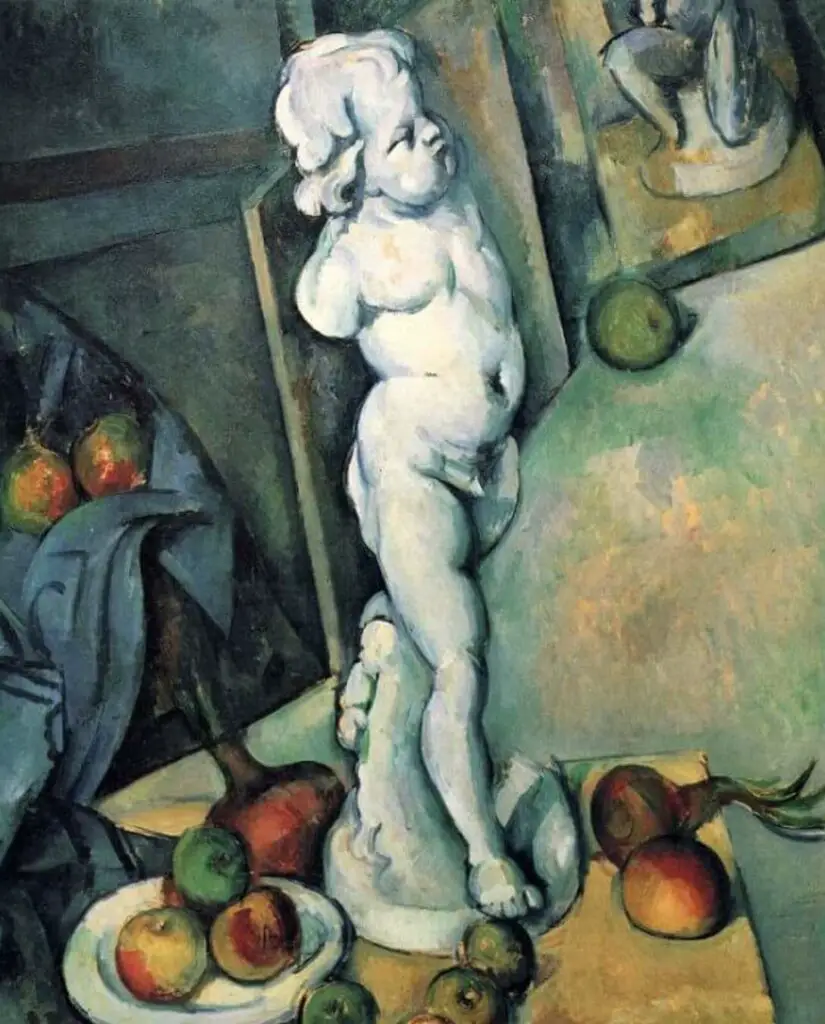
Cezanne’s 1895 still life, “Still Life with Plaster Cupid,” stands out due to its inclusion of Puget’s Cupid sculpture and a background sketch of The Flayed Man. These sculptures were studied from casts, evident in his notebook drawings.
Cezanne’s preference for baroque, emotionally charged sculptures is evident, often depicting themes of passion and struggle. The juxtaposition of these intense figures with ordinary items like apples and onions is unique, highlighting his complexity as both an artist and an individual. This fusion of the extraordinary with the everyday mirrors Cezanne’s intricate nature.
“Houses in Provence” (1883) By Paul Cezanne
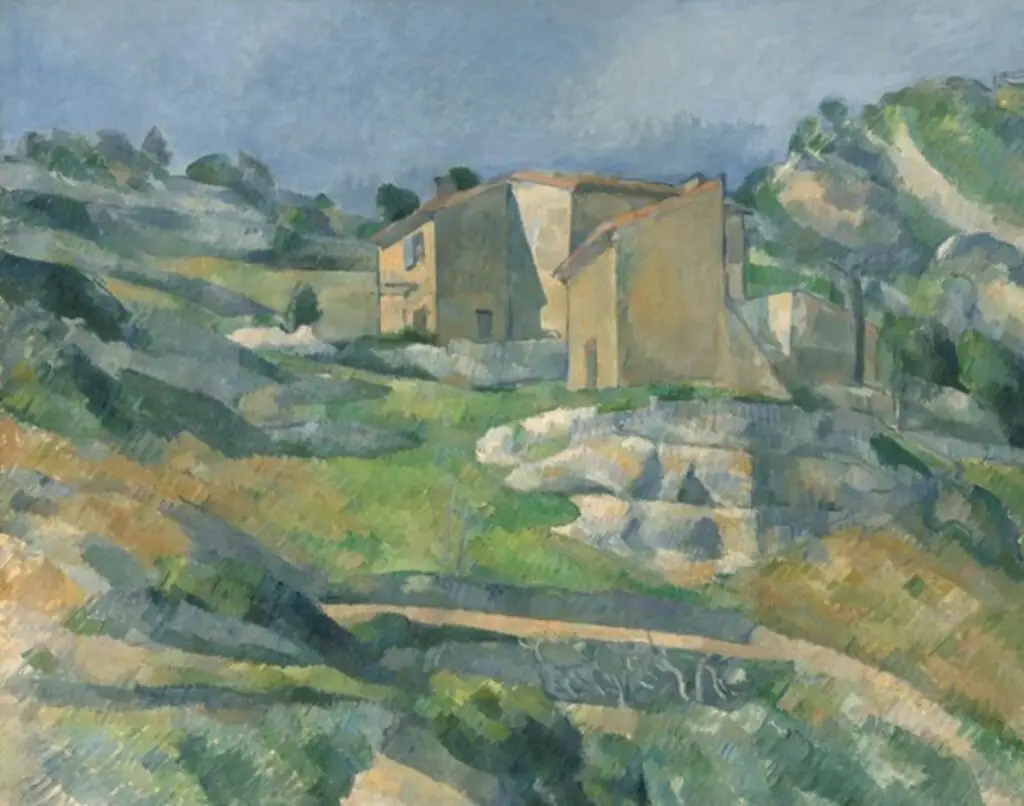
The rustic charm of Provence comes alive in this artwork. The interplay of light and shadow, combined with Cezanne’s iconic brushstrokes, captures the region’s beauty and tranquility.
Paul Cezanne’s art is a symphony of colors, forms, and emotions. His ability to seamlessly blend traditional themes with modern techniques places him on a pedestal in art.
These 15 masterpieces not only highlight Cezanne’s genius but also serve as an inspiration for countless artists across generations, reinforcing his title as the true “father of modern art.”
Anita Louise Art is dedicated to art education, great artists, and inspiring others to find and create their art. We love art that uplifts and inspires. #ArtToMakeYouSmile! #ArtToMakeYouHappy!
If you are interested to see any of my art, you can find out more by clicking here. If you are interested in what inspires me and my paintings, you can discover more by clicking here.
We have a free newsletter and would love you to be part of our community; you can subscribe to the newsletter by clicking here. If you have any questions, I would be happy to talk to you anytime. You can reach me, Anita, by clicking here.
Subscribe to our Anita Louise Art YouTube Channel with great videos and information by clicking here.
Join us for our podcast “5 Minutes With Art.” Spend just 5 minutes a week with us to discover and learn about great art and artists. You can find out more about our podcast by clicking here.
Frequently Asked Questions
Who is Paul Cezanne, and why is he considered the father of modern art?
Paul Cezanne is celebrated as the “pioneer of contemporary art” due to his groundbreaking contributions that bridged the gap between 19th-century Impressionism and the emergence of 20th-century Cubism. His innovative style and unique approach to painting revolutionized the art world.
What defines Cezanne’s signature brushwork, and how does it contribute to his artistic legacy?
Cezanne’s signature brushwork is characterized by short, distinct strokes that convey a sense of texture and depth. This technique, known for its meticulous precision, played a crucial role in shaping his distinctive style and continues to influence artists today.
How did Cezanne’s profound grasp of color impact his artworks, and which paintings exemplify this mastery?
Cezanne’s deep understanding of color is evident in his ability to capture the nuances of light and shadow. Paintings like “Mont Sainte-Victoire” and “The Card Players” showcase his mastery of color, as he skillfully manipulated hues to evoke emotion and atmosphere.
What role did Cezanne play in the transition from Impressionism to Cubism, and how is this evolution reflected in his art?
Cezanne’s art served as a pivotal link between Impressionism and Cubism. His exploration of geometric shapes and the simplification of forms laid the foundation for Cubist principles. Paintings like “Still Life with Basket of Apples” illustrate this transitional phase in his artistic journey.
Can you elaborate on the lasting impact of Cezanne’s structural innovations, particularly in works like “The Bathers”?
“The Bathers” exemplifies Cezanne’s structural innovations, showcasing his emphasis on geometric shapes and the deconstruction of traditional perspectives. This painting, among others, had a profound impact on the development of modern art and inspired future generations of artists.
How did Cezanne’s artistic philosophy differ from his contemporaries, and how is it evident in pieces like “Mount Sainte-Victoire”?
Cezanne diverged from the Impressionist emphasis on capturing fleeting moments and instead focused on the underlying structure of his subjects. “Mount Sainte-Victoire” exemplifies this approach, as he portrayed the landscape with a meticulous attention to form and composition.
What are some key themes and subjects that frequently appear in Cezanne’s work, and why do they hold significance?
Cezanne’s oeuvre often includes landscapes, still lifes, and bathers. These subjects were not just artistic choices but also representations of his philosophical exploration of perception, space, and the nature of reality.
How did Cezanne’s personal life influence his art, and are there specific paintings that reflect this connection?
Cezanne’s personal life, marked by solitude and introspection, is believed to have influenced the contemplative nature of his art. Paintings like “Self-Portrait with a Straw Hat” provide glimpses into his psyche and the emotional depth he infused into his work.
Can you discuss the significance of Cezanne’s “The Card Players” in the context of his career and the art world of his time?
“The Card Players” is considered one of Cezanne’s masterpieces, reflecting his mature style and innovative approach to composition. Its significance lies in its departure from conventional genre paintings, as well as its influence on the evolving art scene of the late 19th and early 20th centuries.
How has Cezanne’s legacy endured, and what makes his artworks relevant and influential in contemporary art?
Cezanne’s legacy endures through the continued appreciation of his artistic innovations. His influence on modern art, particularly the Cubist movement, and his commitment to redefining traditional artistic conventions ensure that his work remains a source of inspiration for artists exploring new frontiers in the ever-evolving world of contemporary art.
Related Questions
Andy Warhol’s Iconic “Dolly Parton, 1985” Explored
The artistic oeuvre of Andy Warhol is synonymous with the exploration and celebration of fame, characterized by his acute interest in personalities who epitomized the vibrant cultural landscape of his time. His fascination found its fullest expression in his portraits, wherein he masterfully translated the persona of the celebrities he portrayed into visual masterpieces.
By clicking here, you can learn more by reading Andy Warhol’s Iconic “Dolly Parton, 1985” Explored.
Exploring Claude Monet’s 13 Most Famous Paintings
Claude Monet, one of the leading figures of the Impressionist movement, Monet’s works encapsulated fleeting moments, evoking profound emotions and immortalizing the ethereal beauty of the natural world. With his revolutionary approach, Monet shattered the conventions of traditional art, giving birth to a new artistic language that celebrated the transient and embraced the ever-changing nature of existence.
By clicking here, you can learn more by reading Exploring Claude Monet’s 13 Most Famous Paintings.
10 Most Important Works Of Henri Matisse – Master Of Color
Henri Matisse, a pioneering figure in modern art, is a luminary whose works continue to captivate and inspire audiences worldwide. Born on December 31, 1869, in Le Cateau-Cambrésis, France, Matisse’s artistic journey traversed various styles and movements, making him a remarkable innovator in the 20th-century art scene.
By clicking here, you can learn more by reading 10 Most Important Works Of Henri Matisse – Master Of Color.

